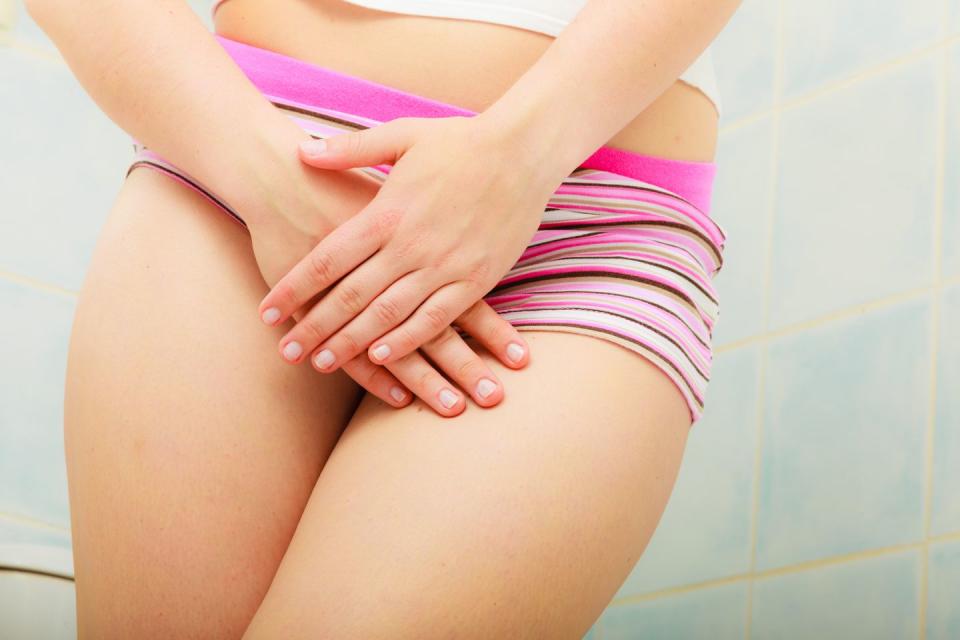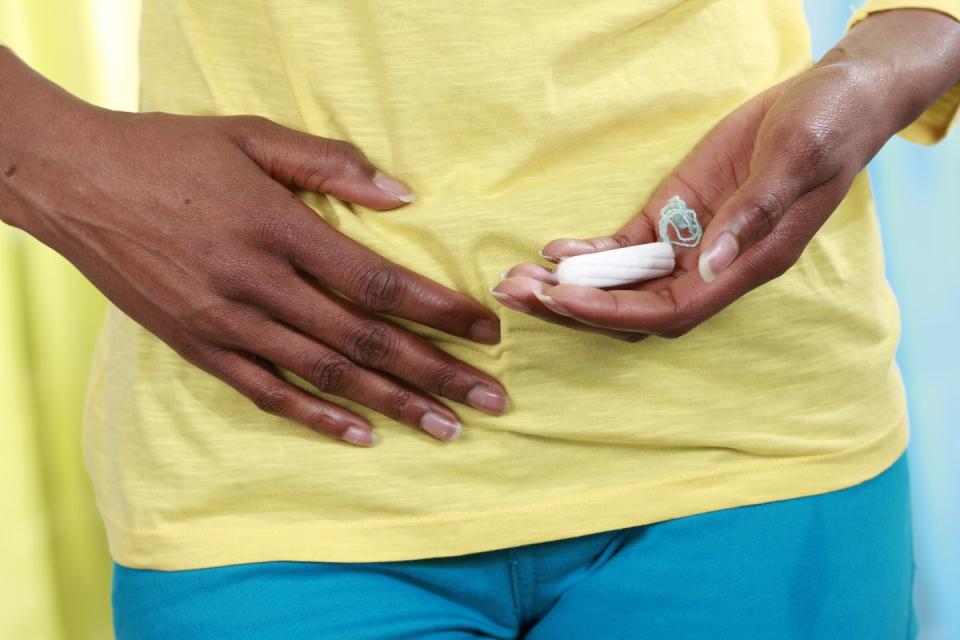Here Are Some Basic Facts About the Vagina That Every Person With One Should Know

"Hearst Magazines and Yahoo may earn commission or revenue on some items through the links below."
A healthy vagina is a happy vagina, and maintaining good vulva and vaginal health is easier than you think — that is, as long as you know what's going on down there. From how it looks, to how it smells, to how it functions, there are a few essential vagina facts that every person (whether they have a vagina or not) should know, especially if you've been too shy to ask or don't know where to look for information. For instance, "vagina" is not an all-encompassing term for everything between your legs, despite what you may have been told.
Instead, the vagina is a muscular, hollow organ that extends from the vaginal opening to the uterus. Because it has muscular walls, the vagina can expand and contract, allowing it to accommodate anything from a tampon, to a finger, to a penis, to a baby. The walls of the vagina are lined with mucous membranes, which keep it protected and moist, and contrary to popular belief, vaginas are mostly able to take care of themselves. They don't require much help to maintain their delicate microbiome, but there are still a few basic facts about the vagina that should be made common knowledge.
Not sure what you can expect to happen to your vagina size after childbirth? Curious to know what happens to your vagina during intercourse? Worried that menopause means the end of your sex life? Read on to find out surprising facts that you may not know about the vagina.
1. You can't really "lose" something in your vagina, like a tampon.
Everyone's heard the myth that things can go missing in there. "The vagina is bounded at the inner end by the cervix and by the vagina's own tissue," nurse practitioner and Coalition to Expand Contraceptive Access deputy director Lisa Stern, RN, MSN, MA, tells Woman's Day. In other words, your vagina is not connected to another area of your body, so don't worry about anything going missing.
However, Sterns says that sometimes a tampon can get lodged deep inside the vagina, like if it's accidentally left in place during intercourse. "If this happens, your healthcare provider should be able to remove it easily with a speculum and forceps," she says.
2. Just like your face, your vagina also wrinkles with age.
Yes, the appearance of your private parts may change with age. "The labia may become less plump as estrogen levels wane, fatty pads in the labia shrink, and less collagen can lead to more sagging," Lissa Rankin, MD, gynecologist and author of What's Up Down There?: Questions You'd Only Ask Your Gynecologist If She Was Your Best Friend, tells Woman's Day. "The skin of the vulva may darken or lighten and the clitoris may shrink. It's normal either way."
Should you be concerned if the color or appearance of your vulva changes over time? Nope — it's totally normal. "These changes, which are often related to decreasing levels of estrogen, do not affect how much pleasure your parts can bring you," Rankin adds.
3. Your vagina and your vulva are not the same thing.
Many people use the term “vagina” in reference to all parts of the female genitalia, including both the internal and external components, but that's actually not accurate. "Vaginas are vaginas," Dr. Angela Jones, OB/GYN, tells Woman's Day. "They are not vulvas. A lot of folks aren’t aware of their basic anatomy and tend to use the terms synonymously."
As Dr. Mary Jane Minkin, OB/GYN at Yale-New Haven Hospital and clinical professor at Yale University School of Medicine, explains to Woman's Day, the vagina is like a "tube" that extends from your cervix to your hymen. Everything you can see — including the clitoris, urethra, labia, and pubis — is part of the vulva.
4. No two vulvas are the same.
Like snowflakes, no two vulvas are the same, and though many people worry that their vulvas don't look "normal," there's really no such thing. The labia majora (outer lips) and labia minora (inner lips) look different on all types of bodies, and normal labia color ranges from pink to red to brown to purplish.
As Dr. Jones explains, "No vagina is the same, and vaginas are special, as there is no other organ that does what it does." So unless you notice a specific spot on your labia that's different in color from the surrounding skin, like a mole or swollen bump, then chances are your vulva is totally normal — special, even!
5. Some vaginal discharge is normal.

According to Janelle King, MPH, BSN, RN, having clear, white, mildly-scented discharge is (more often than not) total normal. However, the amount and consistency of discharge tends to vary from one person to another. "The color and thickness of your discharge will also vary throughout your menstrual cycle — more noticeable near ovulation and the week before your period," King tells Woman's Day.
But not all discharge is normal, so be sure to keep your eyes peeled for any changes. "If your discharge is yellow/green, gray, has a bad smell, or you experience bothersome symptoms like itching or burning, you should follow up with your healthcare provider for testing," King says.
6. Your vagina cleans itself.
Step away from the soap and harsh cleansers, friends, because your vagina keeps itself clean all on its own. "The vagina is lined by a variety of glands that produce the fluids needed to both lubricate and cleanse the vaginal area," Stern explains. "The vast majority of vaginal infections I see in my office are self-induced — generally by those who think they're doing a good thing by washing their vagina with soap and water, or worse, with douche."
As Dr. Jones says, "Vaginas are like self-cleaning ovens, and guess what? They are supposed to smell like vaginas, not a bouquet of roses." Rather than throwing off your complex biome with floral-scented products, trust that your vagina is getting the job done on its own. And speaking of which...
7. Using bath products on your vagina can actually be harmful.
Bath products, particularly those with chemical dyes or fragrances, can irritate the vagina and wash away the beneficial lubricants and flora (bacteria and yeast) that are normal and natural. When these beneficial compounds get washed away, anaerobic bacteria and yeast proliferate and can cause symptoms like discharge, odor and itching. Have you ever had a yeast infection? Yeah, it's not a lot of fun.
"In general, the less you do to it, the better," Dr. Minkin says. While a little mild, hypoallergenic soap on the labia area is okay, trust that your body does a fine job of keeping the insides clean.
8. Having an acidic vagina is a good thing.
Second only to your intestines, your vagina contains more bacteria than anywhere else in your body, according to King. "The 'good' bacteria in your vagina help balance your pH," she says, noting that a healthy range of your vagina's pH is 3.8 to 4.5.
However, when the pH of your vagina is thrown off, it can lead to itching, burning, unpleasant odor, or unusual discharge, which is why it's so important not to wash any area other than your outermost labia, where your pubic hair grows. If you need to restore your vagina's pH levels, Dr. Minkin recommends using RepHresh probiotics.
9. What you eat can affect your vagina.
Another way to keep the balance of your vaginal pH within the healthy range: eating foods associated with good vagina health, like yogurt. A study published in Archives of Gynecology and Obstetrics gave pregnant participants with yeast infections honey and yogurt, and they found that the mixture had similar effects to anti-fungal medications in treating yeast infections.
10. Your vagina grows in size when aroused.
The vagina is nothing if not accommodating. According to Rankin, the average length of a vagina is three to four inches long, but it can double in size. After arousal, the upper portion of the vagina elongates, pushing the cervix and uterus slightly deeper into your body to make room for penetration. Your body's natural ability to self-lubricate helps make penetrative vaginal sex less uncomfortable and more enjoyable as well.
11. Your labia may also change color during arousal.

The color of your vulva may not be the same color as the rest of your skin — for many, it's darker. And according to Dr. Minkin, the color of your labia can temporarily become even darker during arousal as blood rushes to the area.
12. Some vaginas ejaculate with orgasm.
Just like penises, some vaginas ejaculate. Female ejaculation occurs when fluid (but not necessarily urine) is expelled from your urethra during arousal or orgasm, and it's commonly known as squirting (though some research suggests that ejaculating and squirting are two different things)."It definitely happens, and it's not uncommon," Rankin says. "It seems to be a learned skill and happens more commonly as people get older and learn how their bodies work."
So how does it happen? "There are glands around the urethra — the tube between the bladder and the outside world — that probably secrete fluid, particularly when the anterior wall of the vagina is stimulated," Rankin explains. Of course, it's also true that many orgasms happen without ejaculation, and sometimes ejaculation happens without a full-blown orgasm.
13. Not everyone can orgasm from vaginal penetration alone.
According to a 2017 study in The Journal of Sex and Marital Therapy, nearly 40 percent of participants needed clitoral stimulation to orgasm, which means vaginal penetration alone may not allow you to reach the Big O. Some experts even think that the G-spot (which has long been believed to be the key to achieving vaginal orgasm) is a myth.
The term "G-spot" was first coined in the early '80s by sexologist Beverly Whipple, PhD, and her researchers, who described the G-spot as a "small bean" that serves as a powerful erogenous zone. However, in 2012, urologist Dr. Amichai Kilchevsky and his colleagues reviewed 29 studies — including surveys, vaginal tissue biopsies, nerve studies, and ultrasounds — and they didn't find any conclusive evidence of the G-spot's existence.
14. The clitoris has a lot in common with the penis.
That bean-shaped erogenous zone on the apex of your labia minora is way more powerful than you may think. The clitoris has 8,000 nerve endings, which is twice as many as the penis. And though the majority of the clitoris — about four-fifths of it — can't be seen from the outside, it measures roughly the same length as the average flaccid penis (about three-and-a-half inches) when you include the internal parts of the clitoris.
15. Your vagina may change dramatically after childbirth.
A vagina post-childbirth may not look different from the outside, but it will almost certainly feel different. "As a gynecologist, I can almost always tell if someone has delivered vaginally or not," Rankin says. "I need a larger speculum for someone who has had two kids than for someone who's never given birth. But from the outside, you can't tell unless the person has torn during childbirth, in which case they may have a faint scar at the site of the tear or episiotomy."
16. After childbirth, your vagina needs a breather.
It doesn't matter whether you have a vaginal birth or a C-section — doctors still suggest that you avoid penetration for four to six weeks after giving birth, as the vagina needs that time to heal. You may also need to wait longer if you have a perineal tear or episiotomy (because yes, that does happen).
17. Kegels aren't just for those who have given birth.
Kegels are used to increase the strength of your pelvic floor muscles, and according to Dr. Minkin, Kegel exercises can benefit anyone with a vagina. After all, your pelvic floor muscles help support all of your pelvic organs, which including the bladder, uterus, bowel, rectum, and of course, vagina. The best part: You can do them anywhere, anytime. In order to perform a Kegel, simply squeeze the muscles you use to start and stop the flow of urine.
18. There is no "right" period product.

The menstrual products you use during your time of the month should only depend on what makes you feel most comfortable. And while the debate usually comes down to pads versus tampons, King points out that there are other options.
"During your lifetime, you will use somewhere between 5 to 15 thousand pads or tampons, and sadly, most of them will end up in a landfill as plastic waste," she says. If you're looking for a more sustainable product, King suggests using reusable cloth pads, menstrual cups, or menstrual underwear instead of disposal pads and tampons.
19. You experience more vaginal dryness with age.
Your estrogen levels naturally begin to decline during menopause, which can cause your vaginal tissue to become thinner, drier, and more easily irritated. For those who experience vaginal atrophy, sex can feel uncomfortable or even painful due to decreased lubrication. But have no fear: There is a range of treatment options available, including vaginal moisturizers, estrogen creams, and personal lubricants.
"If you opt for the personal lubricant, it is best to use one that is compatible with the healthy range of your vagina's pH," King advises. "Stay away from lubricants that are colored or flavored, since this can cause irritation or infections." Dr. Minkin's recommendation for a vaginal moisturizer: Replens.
20. Getting screened for cervical cancer is essential.
Cancer screenings are used to find abnormal cells on your cervix, and in 2020, the American Cancer Society (ACS) updated its guidelines for cervical cancer screenings. According to their newest guidelines, an HPV test alone is now used as as the preferred screening method for cervical cancer for everyone with a cervix ages 25 to 65, and starting at the age of 25, you should get an HPV test performed every five years. It's also acceptable to get an HPV/Pap co-test done every five years or a Pap smear every three years.
What's the difference between the two? A Pap test looks for abnormal cells that can lead to cancer in the cervix, while an HPV test looks for the human papillomavirus, a virus that can cause cervical cancer. HPV tests are a newer method of cervical cancer screening, and studies have shown that HPV tests are more accurate and more reliable than Pap tests — through both tests can find cervical cancer precursors before they become cancer.
21. Not all women have vaginas, and not all people who have vaginas are women.
Remember: Genitalia does not equal gender, and it can be harmful to assume so. Many people who identify as women weren't born with vaginas, and many people who identify as men or as non-binary do have vaginas.
You Might Also Like


